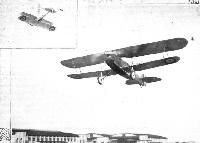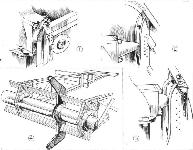Фотографии
-
Dornier Delphin
Самолёты на фотографии: Dornier Delphin - Германия - 1920
-
Регистрационный номер: G-EBBI, G-EBBY, G-EBFO [6] HOME FROM THE CAPE: These three photographs tell the story of the home-coming of Cobham, Elliott and Emmott on Saturday of last week from their flight to Cape Town and back in a D.H.50 fitted with Armstrong-Siddeley "Jaguar" radial air-cooled engine. The photograph shows the D.H.50 arriving over Croydon aerodrome, followed by some of its escorting machines.
Самолёты на фотографии: De Havilland D.H.32 / D.H.34 - Великобритания - 1921De Havilland D.H.50 - Великобритания - 1923Handley Page H.P.18 (W.8) / H.P.30 (W.10) - Великобритания - 1919
-
Регистрационный номер: G-EBFO [6] LONDON - CAPE TOWN - LONDON: The 385 h.p. Armstrong-Siddeley "Jaguar" engine which came through the 17,000 miles and all variations of climatic conditions, without a hitch.
17,000 + 28,000 = 45,000: The Armstrong Siddeley "Jaguar" which accomplished its second big task without a falter.Самолёты на фотографии: De Havilland D.H.50 - Великобритания - 1923
-
Регистрационный номер: G-EBFO [6] LONDON - CAPE TOWN - LONDON: Some "snaps" taken by A. B. Elliott (the engineer of the party) on the outward journey. (1) The arrival at Malakal, Sudan. (2) A native helps to fill up with fuel. (3) An aerial view of the Sennar Dam recently opened to irrigate 1,000,000 acres of desert.
Самолёты на фотографии: De Havilland D.H.50 - Великобритания - 1923
-
Регистрационный номер: G-EBFO [6] FIRST GREETINGS: These two photographs show the crowds surging around the machine as soon as it came to a standstill on the Croydon Aerodrome. In the upper photograph, Mr. Cobham is being hailed by friends, while in the lower picture he is seen being carried to the Customs House.
Самолёты на фотографии: De Havilland D.H.50 - Великобритания - 1923
-
Регистрационный номер: G-EBFO [6] HOME FROM THE CAPE: These three photographs tell the story of the home-coming of Cobham, Elliott and Emmott on Saturday of last week from their flight to Cape Town and back in a D.H.50 fitted with Armstrong-Siddeley "Jaguar" radial air-cooled engine. On the photograph is seen the "50" actually landing after its 17,000 miles' flight.
Самолёты на фотографии: De Havilland D.H.50 - Великобритания - 1923
-
Регистрационный номер: G-EBFO [6] THE MACHINE: The D.H.50 in front of the hangars at Croydon, just before starting on its last "flip'' across to the Stag Lane Aerodrome. Both the machine and its Armstrong-Siddeley "Jaguar" engine were in very good condition, considering the trying conditions under which the 17,000 miles' flight was made.
Самолёты на фотографии: De Havilland D.H.50 - Великобритания - 1923
-
Регистрационный номер: G-EBFK Sea Eagle
Самолёты на фотографии: Supermarine Sea Eagle - Великобритания - 1923
-
Регистрационный номер: G-EBKT, G-EBLI EXAMINING THE ESCORTS: Visitors surround the D.H. "Moths," six of which went out to meet Cobham over Sevenoaks, one of them, piloted by Capt. Geoffrey de Havilland, carrying Mrs. Cobham. Owing to poor visibility, the "Moths" failed to get close to Cobham's machine, and arrived back at Croydon some little time after Cobham had landed.
Самолёты на фотографии: De Havilland Moth / D.H.60 - Великобритания - 1925
-
WIRELESS AND THE SPANISH TRANSATLANTIC FLIGHT: The above diagram shows the Marconi Wireless Direction Finding aerial arrangement as fitted on Comandante Franco's Dornier-Wal seaplane.
Самолёты на фотографии: Dornier Do.J Wal - Германия - 1922
-
Регистрационный номер: J7721 [3] THE "CYGNET'S" BIG BROTHER: In spite of its powerful "Condor" engine, Mr. Bulman handles the Hawker "Horsley" as if it were a light 'plane, as these photographs show, and in his hands the manoeuvrability of the machine is extremely good.
Самолёты на фотографии: Hawker Horsley / Dantorp - Великобритания - 1925
-
Регистрационный номер: J7721 [3] A MODERN DAY-BOMBER: The Hawker "Horsley" is fitted with a Rolls-Royce "Condor" Engine of 650 h.p. The machine, it will be seen, is of very "clean" design, and is characterised by a bottom plane considerably smaller in span and chord than the top plane. The cowling around the engine is particularly neat.
Самолёты на фотографии: Hawker Horsley / Dantorp - Великобритания - 1925
-
Регистрационный номер: J7721 [3] AT FULL SPEED: The Hawker "Horsley" with Rolls-Royce "Condor" engine, piloted by Flight-Lieut. Bulman, flying past the hangars at Brooklands. The inset shows the machine at the top of a loop, an evolution which this astonishing machine seems to perform with the greatest ease.
Самолёты на фотографии: Hawker Horsley / Dantorp - Великобритания - 1925
-
Schreck 21 Hm
Самолёты на фотографии: FBA Type 19 / 21 - Франция - 1924
-
Регистрационный номер: G-EBGG THE BRISTOL "JUPITER" ENDURANCE TEST: Our photo shows the Bristol "Bloodhound" biplane fitted with a sealed "Jupiter" engine, arriving at Croydon, from Filton, on February 25. Since January 4, when the test started, the machine has been making daily trips between these two points, and no engine replacements have yet been made so far. On Tuesday over 200 hours' flying had been completed and over 22,500 miles flown.
Самолёты на фотографии: Bristol Bloodhound / Type 84 - Великобритания - 1923
-
Регистрационный номер: G-EAQT CONVERTED F5 FLYING BOAT: A couple of years ago Short Brothers built this machine for Mr. Lebbeus Hordern of Australia for his private use, and the machine has'done good service as an aerial yacht. Mr. Hordern has now ordered the small all-metal flying boat.
Самолёты на фотографии: Felixstowe F.2 - F.5 - Великобритания - 1917
-
The Short "Mussel": A view of the fuselage, showing the skeleton of the vertical fin.
Самолёты на фотографии: Short Mussel / S.7 - Великобритания - 1926
-
THE SHORT "MUSSEL": This photograph of the stern of the fuselage shows the neat attachment of the fin and stern post to a Duralumin plate forming the rear bulkhead of the fuselage. Note the steel fittings under and on the sides of the stern, which are for the tail skid and tail plane struts respectively. The skid is, of course, for use with the landplane only.
Самолёты на фотографии: Short Mussel / S.7 - Великобритания - 1926
-
THE SHORT "MUSSEL": The neat mounting of the "Cirrus" engine is well brought out in this photograph. The gravity petrol tank may be seen above and aft of the engine.
Самолёты на фотографии: Short Mussel / S.7 - Великобритания - 1926
-
THE SHORT "MUSSEL": Some constructional details. 1, shows a spar section, and also the attachment of an aileron bracket. In 2 is seen an external view of a spar, with the built-up sheet steel fitting which takes one of the lift struts. The latter are placed above the wing, and are thus compression struts. The steel fitting is shown in more detail in 3. A spar root is illustrated in 4. Note the gimbal mounting. In 5 is shown the spar root, built into the lower part of the fuselage, which, in addition to receiving the wing, also supports the undercarriage strut.
Самолёты на фотографии: Short Mussel / S.7 - Великобритания - 1926
-
THE SHORT "MUSSEL": 1, 2 and 3 show details of the very neat engine mounting, the cone-shaped "feet" being bolted to the channel-section formers and secured by bolts projecting through the fuselage covering and readily accessible from outside. Taken in conjunction with the photograph showing the "Cirrus" engine, these sketches clearly explain the simple mounting. In 4 are shown details of the aileron construction, which incorporates wooden ribs attached to a Duralumin tubular spar by the small Duralumin sheet fittings shown.
Самолёты на фотографии: Short Mussel / S.7 - Великобритания - 1926
-
Short S.7 "Mussel" 60 hp. "Cirrus" Engine
Самолёты на фотографии: Short Mussel / S.7 - Великобритания - 1926
-
Регистрационный номер: G-EBJY SUPERMARINE SWAN. Designed by R. J. Mitchell - of the Spitfire - the Swan was the first twin-engined Supermarine flying-boat built. The name was actually first applied to a projected amphibian development of the first British transport flying-boat, the Sea Eagle. This earlier Swan was to have been a smaller machine with a single pusher 450-h .p. Napier Lion engine and accommodation for five passengers and a crew of two. It was not built.
The Swan with which we are concerned here was originally ordered by the Air Ministry (to Specification 21/22) as a twelve-passenger transport amphibian powered by two 360-h .p. Rolls-Royce Eagle IX engines. However, two Swan prototypes (N 174 and N 175) were completed in 1924 as military flying-boats without the amphibian undercarriage . These aircraft were equal-span, two-bay biplanes with monoplane tail units and triple fins and rudders . A feature of their design was a raised "deckhouse" above the lower centre-section containing a side-by-side cockpit for the crew of two.
One of the Swan prototypes was tested at the Marine Aircraft Experimental Establishment at Felixstowe in 1924 and showed such promise that an Air Ministry Specification (R.18/24) was issued soon afterwards for a development, later built by Supermarine as the first of the famous Southamptons.Самолёты на фотографии: Supermarine Swan - Великобритания - 1924
-
Jasmund
Самолёты на фотографии: LFG V.20 Arkona / V.101 Jasmund - Германия - 1922
-
Arkona
Самолёты на фотографии: LFG V.20 Arkona / V.101 Jasmund - Германия - 1922
-
TWO MACCHI LIGHT 'PLANES: On the left the Macchi 20 Seaplane, which was classed first in the recent "Coppa del Mare," and the Macchi 20 land 'plane, which was classed second in the "Coppa d'Italia." Both types were fitted with 60 h.p. Lawrence air-cooled engines
Самолёты на фотографии: Macchi M.16/M.20 - Италия - 1919
-
BEACHING CHASSIS OF SUPERMARINE "SOUTHAMPTON." On the left the chassis is shown in the down position, while on the right it is shown at the top of its travel. .
Самолёты на фотографии: Supermarine Southampton / Solent - Великобритания - 1925
-
THE VICKERS "VENDACE" TRAINING BIPLANE: Some constructional details. 1. This sketch shows the lower rear wing-hinge fitting - the wing being folded half-way back - and the crank, mounted on the hinge bolt, through which the ailerons are actuated, thereby enabling the wings to be folded back without upsetting the aileron adjustment. Note the neat metal fairings on the plane edges. 2. The forward end of one of the engine bearers, showing the front engine bracket and the suspension of radiator. 3. The adjustable seat, shown in normal position, and 4, in raised position. Adjustment is effected by means of the hand lever through an Auto-Lock (friction) device. 5. The Oleo tail-skid with 6, a diagram of the complete unit.
Самолёты на фотографии: Vickers Vendace / Type 120 - Великобритания - 1926
-
Vickers "Vendace" Rolls-Royce "Falcon" III Engine
Самолёты на фотографии: Vickers Vendace / Type 120 - Великобритания - 1926
-
Регистрационный номер: G-EBKV THE "NIMBUS" IN FLIGHT: Mr. Perry flying past the A.D.C. Aircraft works at Croydon Aerodrome, on a D.H.9 fitted with the "Nimbus" engine. Inset, the machine is shown at the top of a loop. With this engine the speed of the D.H.9 3-seater is about 135 m.p.h.
Самолёты на фотографии: De Havilland D.H.9B / D.H.9C - Великобритания - 1919
-
The Bristol "Berkeley" is a Day-Bomber with Rolls-Royce "Condor" Engine. The machine is built entirely of metal, with novel forms of steel construction for main members and Duralumin for minor parts.
Самолёты на фотографии: Bristol Berkeley / Type 90 - Великобритания - 1925
-
Регистрационный номер: J7403 The Bristol "Berkeley" is a day bomber fitted with Rolls-Royce "Condor" Engine. The machine is of all-metal construction, with steel as the material used for the main structure members and Duralumin for minor parts. For the Bristol-Frise patented balanced ailerons it is claimed that they introduce no yaw to interfere with the sighting of the bomber. The pilot's cockpit is placed ahead of the wings, where his view is particularly good.
Самолёты на фотографии: Bristol Berkeley / Type 90 - Великобритания - 1925
-
L&O H150
Самолёты на фотографии: Liore et Olivier LeO H.15 - Франция - 1926
Статьи
- Flight

































